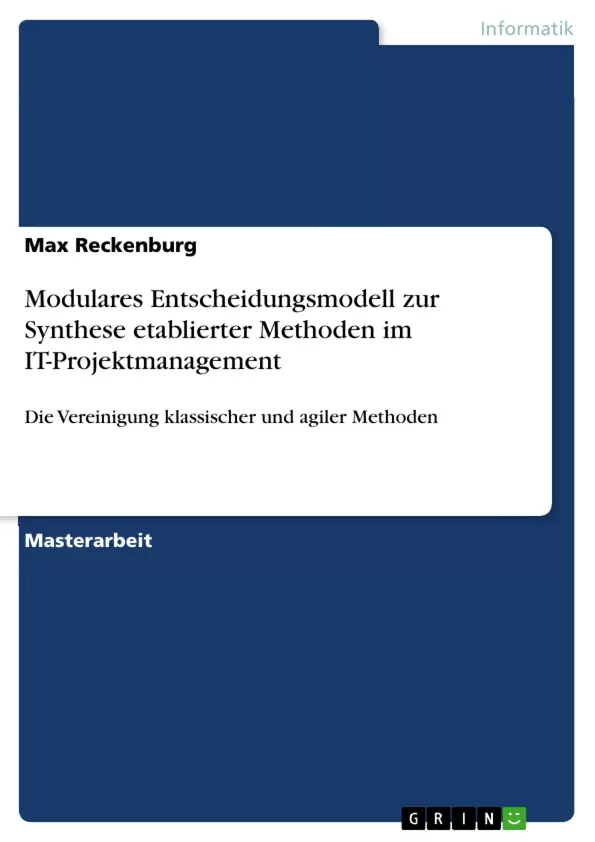Diese mit Bestnote bewertete Master-Thesis stellt ein Entscheidungsmodell vor, mit dem sich klassische IT-Projektmanagement-Methoden (Wasserfall) mit agilen Methoden (z.B. Scrum) vereinen lassen. Bei der Auswahl der für den eigenen Projektkontext erfolgsversprechenden Methoden-Kombination werden Unterschiede und Besonderheiten berücksichtigt, die sich durch verschiedene Projekt-Settings – wie bspw. Teamgröße und Budgetumfang – ergeben. Insofern bietet das in dieser Thesis erarbeitete und aufgezeigte Entscheidungsmodell eine flexible Entscheidungsunterstützung für IT-Projektleiter unterschiedlichster Projekt-Rahmenbedingungen.
Die Ergebnisse dieser Master-Thesis basieren auf einer wissenschaftlich durchgeführten Umfrage. Die Ergebnisse lassen sich insofern auch im Kontext ähnlicher Fragestellungen im Themenkomplex des IT-Projektmanagements weiterverwenden.
Weiterhin bietet diese Thesis neben einem sehr umfangreichen Quellenverzeichnis und Anhang auch Ansatzpunkte für weiterführende Themen einer wissenschaftlichen Arbeit.
Inhaltsverzeichnis
- Abbildungsverzeichnis
- 0 Abstract
- 1 Einleitung
- 2 Projektmanagement-Methoden
- 2.1 Definitionen und Einordnung
- 2.2 Competence Baseline
- 2.2.1 Einleitung
- 2.2.2 Verfahren
- 2.2.2.1 Abdeckungsanalyse
- 2.2.2.2 Anforderungsmanagement
- 2.2.2.3 Auftraggeberbefragung
- 2.2.2.4 Aufwandtrendanalyse
- 2.2.2.5 Befugniszuweisung
- 2.2.2.6 Belastungsselbstreflexion
- 2.2.2.7 Benutzerbefragung
- 2.2.2.8 Externes Projektcoaching
- 2.2.2.9 Finanzmittelplanung
- 2.2.2.10 Innovationsmanagement
- 2.2.2.11 Konfliktprävention
- 2.2.2.12 Kosten-Nutzen-Analyse
- 2.2.2.13 Kostentrendanalyse
- 2.2.2.14 Krisenfrüherkennung
- 2.2.2.15 Kritischer Pfad
- 2.2.2.16 Mehrdimensionales Denken
- 2.2.2.17 Meilensteintrendanalyse
- 2.2.2.18 Mitarbeiterbefragung
- 2.2.2.19 Nutzenanalyse
- 2.2.2.20 Projektcontrolling
- 2.2.2.21 Projekt(management)-Benchmarking
- 2.2.2.22 Projektmanager-Zertifizierungen
- 2.2.2.23 Risikomanagement
- 2.2.2.24 Situationsanalyse
- 2.2.2.25 Stakeholdermanagement
- 2.2.2.26 SWOT-Analyse
- 2.2.2.27 Total Quality Management
- 2.2.2.28 Wirtschaftlichkeitsrechnung
- 2.2.3 Artefakte
- 2.2.3.1 Ethikkodex
- 2.2.3.2 Glossar
- 2.2.3.3 Kommunikationsplattformen
- 2.2.3.4 Lastenheft
- 2.2.3.5 Machbarkeitsstudie
- 2.2.3.6 Meilensteinnetzplan
- 2.2.3.7 Persönlichkeitsprofile
- 2.2.3.8 Pflichtenheft
- 2.2.3.9 Rollenanforderungsprofile
- 2.2.3.10 Ursachen-Wirkungsdiagramm
- 2.3 Body of Knowledge Guide
- 2.3.1 Einleitung
- 2.3.2 Organisation
- 2.3.2.1 Ausgeglichene Matrixorganisation
- 2.3.2.2 Funktionsorientierte Organisation
- 2.3.2.3 Projektorientierte Organisation
- 2.3.2.4 Ressourcenverfügbarkeit Teilzeit
- 2.3.2.5 Ressourcenverfügbarkeit Vollzeit
- 2.3.2.6 Schwache Matrixorganisation
- 2.3.2.7 Starke Matrixorganisation
- 2.3.3 Verfahren
- 2.3.3.1 Budgetreserve
- 2.3.3.2 Change Management
- 2.3.3.3 Experteneinbeziehung
- 2.3.3.4 Macht-Interessen-Analyse
- 2.3.3.5 Make-or-Buy-Analyse
- 2.3.3.6 Phasenorientiertes Projektmanagement
- 2.3.3.7 Qualitätskosten
- 2.3.3.8 Qualitätsmetriken
- 2.3.3.9 Scope-Management
- 2.3.3.10 Szenarienanalyse
- 2.3.3.11 Teambildung und -erhaltung
- 2.3.4 Artefakte
- 2.3.4.1 Unternehmensweite Informationsdatenbank
- 2.3.4.2 Verantwortlichkeitsmatrix
- 2.4 Projects in Controlled Environments 2
- 2.4.1 Einleitung
- 2.4.2 Organisation
- 2.4.2.1 Änderungsausschuss
- 2.4.2.2 Lenkungsausschuss
- 2.4.2.3 Projektmanager
- 2.4.2.4 Projektsicherungsteam
- 2.4.2.5 Projektunterstützung
- 2.4.2.6 Teammanager
- 2.4.3 Verfahren
- 2.4.3.1 Kommunikationsmanagement-Strategie
- 2.4.3.2 Konfigurationsmanagement-Strategie
- 2.4.3.3 Pre-Projektphase
- 2.4.3.4 Qualitätsmanagement-Strategie
- 2.4.3.5 Risikomanagement-Strategie
- 2.4.3.6 Steuern nach dem Ausnahmeprinzip
- 2.4.4 Artefakte
- 2.4.4.1 Arbeitspakete
- 2.4.4.2 Ausnahmebericht
- 2.4.4.3 Business Case
- 2.4.4.4 Erfahrungsbericht
- 2.4.4.5 Erfahrungsprotokolle
- 2.4.4.6 Konfigurationsdatensätze
- 2.4.4.7 Nutzenrevisionsplan
- 2.4.4.8 Offene-Punkte-Liste
- 2.4.4.9 Phasenabschlussbericht
- 2.4.4.10 Phasenplan
- 2.4.4.11 Produktbeschreibung
- 2.4.4.12 Produktstatusauskunft
- 2.4.4.13 Projektabschlussbericht
- 2.4.4.14 Projektbeschreibung
- 2.4.4.15 Projektleitdokumentation
- 2.4.4.16 Projektplan
- 2.4.4.17 Projektstatusbericht
- 2.4.4.18 Projekttagebuch
- 2.4.4.19 Qualitätsregister
- 2.4.4.20 Risikoregister
- 2.4.4.21 Teamplan
- 2.4.4.22 Teamstatusbericht
- 2.5 Scrum
- 2.5.1 Einleitung
- 2.5.2 Organisation
- 2.5.2.1 Moderator
- 2.5.2.2 Product Owner
- 2.5.3 Verfahren
- 2.5.3.1 Aufwand-Schätz-Meeting
- 2.5.3.2 Daily Standup
- 2.5.3.3 Kick-off-Workshop
- 2.5.3.4 Produktreviews
- 2.5.3.5 Projektretrospektive
- 2.5.3.6 Selbstorganisiertes Entwicklungsteam
- 2.5.3.7 Sprints
- 2.5.4 Artefakte
- 2.5.4.1 Definition of Done
- 2.5.4.2 Definition of Ready
- 2.5.4.3 Product Backlog
- 2.5.4.4 Taskboard
- 2.5.4.5 User Stories
- 2.5.4.6 Vision
- 3 Entwicklung des Entscheidungsmodells
- 3.1 Einleitung
- 3.2 Clustering der Kernmodule
- 3.3 Umfrage
- 3.3.1 Zielsetzung- und Definition
- 3.3.2 Design
- 3.3.2.1 Umfragebedingungen und -art
- 3.3.2.2 Inhaltliche Elemente
- 3.3.2.3 Visuelle Gestaltung
- 3.3.2.4 Rahmenbedingungen und Pretest
- 3.3.3 Ergebnisse
- 3.3.3.1 Umfragedurchführung und -daten
- 3.3.3.2 Erfolgsdefinition
- 3.3.3.3 Erste sekundäre Forschungsfrage
- 3.3.3.4 Zweite sekundäre Forschungsfrage
- 3.3.3.5 Primäre Forschungsfrage
- 3.4 Entscheidungsmodell
- 4 Anwendung des Entscheidungsmodells
- 4.1 Generische Anwendung
- 4.2 Praxisbeispiele
- 4.2.1 Erfolgreiches Projekt
- 4.2.2 Gescheitertes Projekt
- 5 Bewertung des Entscheidungsmodells
- 6 Zusammenfassung und Ausblick
- Literaturverzeichnis
- Anhang
- Erfolgsfaktoren für IT-Projekte
- Synthese etablierter Projektmanagement-Methoden
- Entwicklung eines Entscheidungsmodells für die Methodenwahl
- Abhängigkeit der Methodenwahl vom Projektsetting und Projekterfolg
- Praxisrelevante Anwendung des Entscheidungsmodells
Zielsetzung und Themenschwerpunkte
Die vorliegende Master-Thesis beschäftigt sich mit der Entwicklung eines modularen Entscheidungsmodells für die Synthese etablierter Methoden im IT-Projektmanagement. Das Ziel ist die Steigerung der Erfolgswahrscheinlichkeit von IT-Projekten durch die gezielte Auswahl und Kombination von Methodenelementen, basierend auf den spezifischen Rahmenbedingungen des jeweiligen Projektes. Die primäre Forschungsfrage lautet: Welche Clustermodule erhöhen die Erfolgswahrscheinlichkeit eines IT-Projektes und welche reduzieren diese in Abhängigkeit vom Projektsetting?
Zusammenfassung der Kapitel
Die Master-Thesis gliedert sich in sechs Kapitel. Kapitel 1 führt in das Thema ein und erläutert die Problematik der Auswahl und Anwendung von Projektmanagement-Methoden. In Kapitel 2 werden etablierte Projektmanagement-Methoden und deren Kernmodule vorgestellt. Kapitel 3 beschreibt den Entwicklungsprozess des Entscheidungsmodells, einschließlich des Clusterings der Kernmodule, der Durchführung einer Umfrage unter IT-Projektmanagern und der statistischen Analyse der Umfragedaten. Die Anwendung des Entscheidungsmodells wird in Kapitel 4 anhand von realen Projekten demonstriert. In Kapitel 5 erfolgt eine kritische Würdigung des entwickelten Modells und die Darstellung der Grenzen des Modells im Hinblick auf Aussagekraft und Anwendung. Die Master-Thesis endet mit einer Zusammenfassung und einem Ausblick auf weitere Forschungsmöglichkeiten.
Schlüsselwörter
Die Master-Thesis befasst sich mit den Themen IT-Projektmanagement, Projektmanagement-Methoden, Hybrid Project Management Model, Entscheidungsmodell, Clustermodule, Projektsetting, Projekterfolg, Umfrage und statistische Analyse.
- Quote paper
- Max Reckenburg (Author), 2015, Modulares Entscheidungsmodell zur Synthese etablierter Methoden im IT-Projektmanagement, Munich, GRIN Verlag, https://www.grin.com/document/1377375




